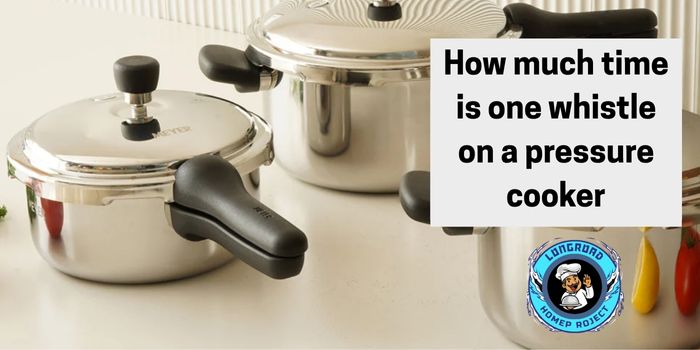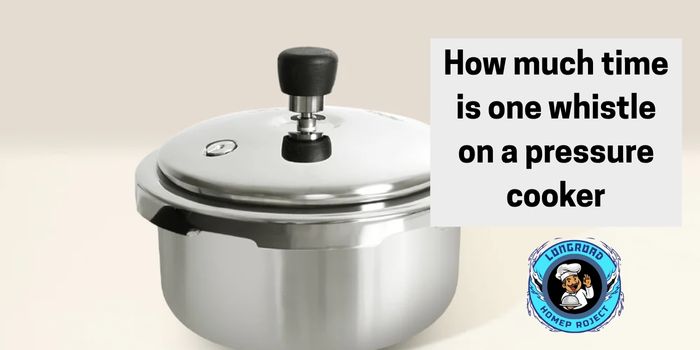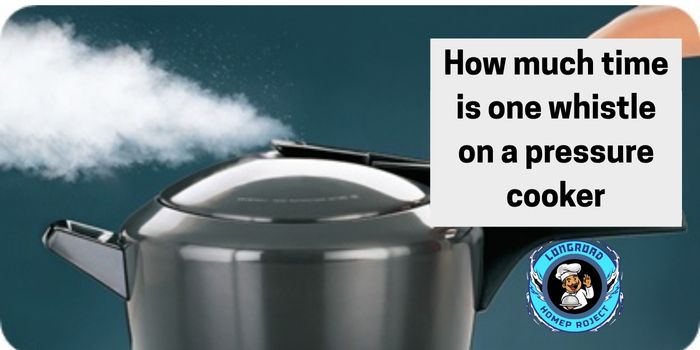As an Amazon Associate I earn from qualifying purchases.
How much time is one whistle on a pressure cooker? That’s a surprisingly common question—especially if you’re just getting started with pressure cooking. Understanding how pressure cookers work and what the “whistle” actually means can be the difference between a perfectly tender meal and a kitchen mishap.
For millions around the world, the sound of that first whistle is almost nostalgic. It’s more than noise—it’s a signal, a timer, a tradition. But if you’ve ever wondered how long one whistle really is in terms of minutes, or why different recipes ask for a different number of whistles, you’re in the right place.
In this article, we’ll break down everything you need to know about pressure cooker whistles—from how they function to how they translate into cooking time. Whether you’re cooking lentils, rice, or chicken, we’ll help you stop guessing and start cooking with confidence.
Let’s begin by understanding the heart of it all: how pressure cookers work, and what role the whistle plays in that process.
How Pressure Cookers Work (Simplified)
Pressure cookers are sealed cooking pots that trap steam to build pressure, raising the boiling point of water and significantly speeding up the cooking process. This high-pressure environment allows food to cook faster, retain moisture, and develop deep flavors in a short time.
Here’s what happens step-by-step:
- You place food and a small amount of water inside the pressure cooker.
- As the pot heats up, steam builds and pressure begins to rise.
- Once the internal pressure reaches a set limit, the pressure release system—usually a weighted valve or spring-loaded mechanism—begins to release steam.
- This release makes the classic whistling sound—your audible indicator that the pressure level has been reached.
From this point on, most recipes count “whistles” as cooking time milestones.
What Is a “Whistle” and Why It Matters
A “whistle” refers to the burst of steam released by the pressure regulator on top of the lid. It’s a short hiss or toot that usually lasts 1–3 seconds. Each whistle means the cooker has built up enough internal pressure to release excess steam—keeping it within safe limits.
But why does it matter?
Because in many cultures—especially in Indian, Middle Eastern, and Asian kitchens—recipes are written using whistles as timing references instead of minutes. For example:
- 2 whistles = Light cooking (e.g., white rice or soft vegetables)
- 4–5 whistles = Medium (e.g., lentils, potatoes)
- 7+ whistles = Heavier proteins or tougher cuts (e.g., chickpeas or chicken)
Understanding what one whistle represents in actual time (spoiler: usually 2–3 minutes after pressure is reached) helps you translate those recipes to your own stove and cooker setup.
Types of Pressure Cookers: Weighted vs Spring Valve
Not all whistles are created equal. Your pressure cooker’s design affects how often and how loudly it whistles.
Let’s break it down:

Weighted Valve Pressure Cookers (a.k.a. Traditional Models)
These are the most common in Indian kitchens. They have a jiggler or weight on top that lifts when pressure exceeds a certain point—releasing steam and making a loud whistle.
- Each whistle = a release of excess steam
- Easy to count but less precise in time control
- Ideal for recipes that say “cook for 3–4 whistles”
Spring Valve or Modern Pressure Cookers
Used more commonly in the US and UK (like Instant Pot or T-fal models), these do not make traditional whistles. Instead, they use a silent spring valve that holds in pressure and may only hiss slightly during operation.
- You need to use a timer instead of counting whistles
- Pressure levels are often controlled digitally
- More consistent results, but less “intuitive” than whistling cookers
So, if you’re using a spring valve cooker, you’ll need to convert whistle-based recipes into minutes (don’t worry—we’ll help you do that later in this guide).
Why This Matters to You
Understanding how your cooker releases steam helps you:
- Translate recipes that call for whistles into timed cook durations
- Avoid overcooking or undercooking food
- Choose the right model for your kitchen style and needs
And most importantly, it gives you the confidence to cook more meals at home—meals that are healthy, fast, and packed with flavor.
How Long Is One Whistle on a Pressure Cooker?
If you’re new to cooking with a stovetop pressure cooker, the concept of a “whistle” might be a bit confusing at first. Many recipes call for “2 whistles,” “4 whistles,” or even more — but how long is one whistle, exactly?
Average Duration of One Whistle: 1–2 Minutes
In most cases, one whistle lasts between 1 to 2 minutes. This is the time it takes from when the pressure builds up and forces steam through the pressure regulator (the “whistle” or weight valve) until it naturally quiets down. However, this duration isn’t set in stone. A whistle’s length depends on several factors, including:
- The brand of the pressure cooker
- Stovetop heat intensity
- Quantity of food and water inside
- And the type of dish being cooked
As a general rule of thumb, if your cooker emits a steady, loud burst of steam and then quiets down, that counts as one whistle.
Variables Affecting Whistle Duration
Stove Type
Gas stoves usually heat up faster than electric or induction cooktops, which may cause a whistle to occur more quickly. On a high flame, a whistle can happen in under a minute, while on a low or medium flame, it might take closer to two minutes or more.
Heat Level
The intensity of the flame plays a big role. Cooking on high heat means whistles happen rapidly — often back-to-back — whereas medium or low heat will slow things down, making each whistle take longer.
Tip: Once the cooker reaches pressure and whistles once, many people reduce the heat to medium or low to control cooking better and prevent overcooking.
Pressure Cooker Size and Load
Larger pressure cookers (5 liters and above) take more time to build up pressure compared to smaller ones (like 2 or 3 liters). Also, if the cooker is full or contains thicker ingredients like dal, meat, or biryani, it takes longer for each whistle.
Personal Experience: Comparing Brands
Having used several brands over the years, I’ve noticed distinct differences:
- Prestige pressure cookers tend to have a sharper, louder whistle that lasts around 1 minute.
- Hawkins pressure cookers, on the other hand, often build pressure more gradually, and their whistle can stretch to nearly 2 minutes, especially if the lid style has a slightly tighter seal.
- My Butterfly pressure cooker has a softer whistle, and sometimes you’ll barely hear it unless you’re in the same room.
Understanding Whistle Timing
| Condition | Average Whistle Duration |
|---|---|
| High flame on gas stove | 45 seconds to 1 minute |
| Medium flame | 1–2 minutes |
| Low flame or electric stove | 2–2.5 minutes |
| Larger cooker with heavy load | Up to 3 minutes per whistle |
So, next time a recipe calls for “3 whistles,” you can estimate it to mean about 3 to 6 minutes of cooking at full pressure, depending on your heat level and cooker size.
Time Conversion Table: Whistles to Minutes
Understanding how long each whistle lasts can help you convert traditional pressure cooker recipes into more precise cooking times. Below is a general time estimate based on average stove settings and common pressure cooker models like Prestige or Hawkins.
| 🔔 Whistles | ⏱️ Estimated Time (Minutes) |
|---|---|
| 1 Whistle | 1.5 – 2 minutes |
| 2 Whistles | 3 – 4 minutes |
| 3 Whistles | 5 – 6 minutes |
| 4 Whistles | 7 – 8 minutes |
| 5 Whistles | 9 – 10 minutes |
| 6 Whistles | 11 – 12 minutes |
| 7 Whistles | 12 – 14 minutes |
Note: These are rough averages. Actual cooking time per whistle can vary based on:
- Gas vs. induction stove
- Pressure cooker size (2L, 5L, etc.)
- Altitude and ambient pressure
- Amount of food and water inside
For best results, always monitor your dish closely the first time, then adjust for future cooks based on your personal cooker’s behavior.
How Many Whistles for Different Foods?
Wondering how many whistles you need to perfectly cook your favorite dishes in a pressure cooker? Here’s a quick guide to help you get consistent, delicious results every time:
| 🥘 Food Item | 🔔 Recommended Whistles | 💡 Tips |
|---|---|---|
| Rice | ✅ 1 to 2 whistles | Use a 1:2 rice-to-water ratio for fluffy texture. |
| Dal / Lentils | ✅ 2 to 3 whistles | Soaking lentils 30 mins ahead speeds up cooking. |
| Chicken | ✅ 3 to 4 whistles | Add spices before pressure cooking for deep flavor. |
| Mutton / Beef | ✅ 6 to 8 whistles | Bone-in cuts may need 1–2 extra whistles. |
| Vegetables | ✅ 1 to 2 whistles | Avoid overcooking to preserve texture and color. |
| Potatoes | ✅ 3 to 4 whistles | Cut into chunks for even cooking. |
| Chickpeas / Beans | ✅ 6 to 7 whistles (or soak + 3–4) | Soak overnight to reduce cooking time and whistles. |
Pro Tip: Always let the pressure release naturally for meats and legumes to retain tenderness and avoid splitting.

Factors That Can Affect Whistle Time
Not all pressure cookers whistle the same. The time between whistles—and how long each one lasts—can vary depending on several key factors. Understanding these can help you avoid undercooked or overcooked meals.
Altitude and External Air Pressure
At higher altitudes, water boils at a lower temperature. This means food takes longer to cook, and whistles might be delayed. If you live in a hilly or mountainous area, you may need extra whistles or cooking time.
Gas vs. Electric Stove
Gas stoves typically heat up and cool down faster than electric stovetops. That means whistles may come sooner on gas than electric. On electric stoves, the residual heat may continue cooking even after turning it off.
Quantity of Water and Ingredients
More water or a larger amount of food means the cooker takes longer to build pressure—delaying the first whistle. Similarly, adding too little water can cause food to scorch or the cooker to whistle too early.
Age and Condition of the Pressure Cooker
An older pressure cooker may have worn-out seals or a clogged whistle regulator, which can delay pressure buildup or cause inconsistent whistling. Always inspect the gasket and valve regularly.
Pre-Soaked vs. Dry Ingredients
Pre-soaked beans, lentils, and grains cook faster and require fewer whistles than dry ones. If you’re cooking without soaking, add more water and plan for a few extra whistles.
Personal Tips for Using Whistles as a Timer
Over time, I’ve learned that whistles aren’t always the most accurate way to time a dish. Here’s what works better for me—and might for you too.
Why I Prefer Counting Minutes Instead of Whistles
Whistles can vary in timing based on your stove, ingredients, or even the weather! I’ve found it more reliable to measure time using a timer or clock instead of depending solely on the number of whistles.
How to Test Your Cooker’s Average Whistle Duration
Do a simple test: Fill your cooker with water, bring it to pressure, and time how long it takes between whistles. Repeat 2–3 times to find an average. Most cookers whistle every 1.5 to 2 minutes under standard conditions.
Using Phone Timers for Consistency
Set a timer on your phone when the cooker starts whistling. It helps you stay consistent, especially for delicate recipes like biryani or steamed veggies where timing is crucial.
Tips to Avoid Undercooking or Overcooking
- Always start counting whistles after the first one.
- Use natural pressure release for meats and legumes.
- For rice and dal, do a quick release after the last whistle to avoid overcooking.
- Keep a notebook or note app to jot down successful timing combinations for future reference.
When Whistle Counts Don’t Work
There are times when counting whistles just isn’t possible—or reliable. Whether your pressure cooker is silent, electric, or simply doesn’t whistle like traditional stovetop models, here’s what to do instead.
What If Your Cooker Doesn’t Whistle?
Some modern pressure cookers—especially newer models or international brands—don’t produce the loud, steam-blasting whistles we’re used to. Instead, they may use pressure indicators, timers, or digital settings. If that’s the case, whistle counting simply won’t apply.
Using Silent or Electric Pressure Cookers
Electric pressure cookers like the Instant Pot, Ninja Foodi, or Prestige Svachh are designed to be quiet. They don’t whistle at all. Instead, they rely on built-in timers and digital pressure indicators. Here’s how to work with them:
- Follow the timer-based cooking instructions given in your recipe or appliance manual.
- Use the “Manual” or “Pressure Cook” setting to choose the exact number of minutes.
- Rely on the pressure indicator light or float valve to know when it’s cooking or releasing steam.
These models offer precise control, so while you lose the traditional whistle cues, you gain reliability and consistency.
How to Measure Time Without Relying on Whistles
If your cooker doesn’t whistle—or if you prefer more precision—here’s how to cook by time instead:
- Start timing once the cooker reaches full pressure. You’ll usually hear a subtle hiss or see a steam indicator pop up.
- Use a stopwatch or phone timer to track the exact cooking duration.
- Refer to trusted cooking charts or manufacturer manuals for time estimates based on food type and quantity.
- For stovetop cookers: Reduce the heat to “low” once full pressure is reached, then begin timing (e.g., 8 minutes for dal, 12–15 for chickpeas).
Pro Tip: Keep a cooking journal! Record how long each dish takes with your specific cooker. This becomes your personal guide—more useful than generic whistle counts.

FAQs
How many minutes is one whistle on a pressure cooker?
✅ One whistle typically equals 1.5 to 2 minutes, depending on the stove heat and pressure level.
How many whistles for rice in a pressure cooker?
✅ For regular white rice, 1 to 2 whistles is usually enough for perfectly cooked grains.
How long is 4 whistles in pressure cooker time?
✅ Four whistles equal approximately 7 to 8 minutes of pressure cooking time.
What does 4 whistles mean in cooking terms?
✅ It usually means about 7–8 minutes of high-pressure cooking, often used for dals, curries, or chicken.
How many whistles to cook chicken in a pressure cooker?
✅ For bone-in chicken, 3 to 4 whistles are generally needed for tender results.
Is 2 whistles enough for rice?
✅ Yes, 2 whistles is typically enough for white rice. Brown rice or wild rice may require more whistles or extra time.
Conclusion
Mastering the art of pressure cooker whistles isn’t just about following a fixed rule—it’s about learning the rhythm of your specific cooker, stove, and ingredients. Here’s a quick recap to keep you on track:
- One whistle usually equals 1.5 to 2 minutes of pressure cooking time.
- Different foods need different whistle counts—rice may need just 1–2, while meats can take up to 8.
- Whistle timing varies depending on the brand of cooker, type of stove (gas or electric), altitude, and even how much food and water you’re using.
- Using a timer alongside counting whistles can give you consistent results—especially if your cooker doesn’t whistle loudly or clearly.
Remember, pressure cooking is part science, part intuition. Don’t be afraid to experiment and note your results. Over time, you’ll develop a reliable sense of how many whistles (or minutes) your favorite dishes need.
As an Amazon Associate I earn from qualifying purchases.